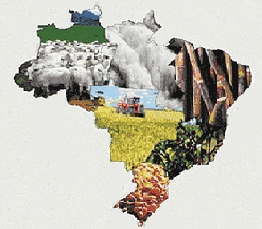Pensando no setor agrícola brasileiro, alguns fatos a se considerar:
Nos últimos 20 anos, o país saltou de autossuficiente e mesmo importador líquido de vários produtos agrícolas para o posto de net exporter do agronegócio, transformando a dinâmica do trading global, antes liderada principalmente pelos Estados Unidos e União Europeia. De 1993 a 2013, a produção nacional de grãos evoluiu de 68,0 milhões para 186,9 milhões de toneladas, enquanto o saldo de exportação de produtos agropecuários apresentou um crescimento médio anual de 13%, totalizando US$ 100,6 bilhões em 2013, vindo a conquistar um market share mundial de 34%.
No que tange a proteína animal, o país representa, atualmente, 19% de toda a carne bovina exportada mundialmente, 35% da carne de frango e 9% da carne suína, acompanhando não só variáveis como crescimento populacional e de renda per capita, como também expandindo a oferta para atender a novos demandantes, anteriormente abastecidos por outras economias ou que não possuíam um perfil consumidor de carnes relevante. Esses e demais eventos exerceram influência direta na tecnificação agrícola, na elevação da produtividade média e, em última instância, no crescimento do Produto Interno Bruto (PIB) do Agronegócio (de R$ 648 bilhões há 20 anos para cerca de R$ 1 trilhão em 2013).
De 1994 até o período presente, a população brasileira cresceu próxima a 30%, enquanto a produção de grãos nacional expandiu 160%, sob inovações de origem mecânica e bioquímica. Grande parte do excedente produtivo resultante dessas transformações foi direcionada ao mercado externo.
Nada disso teria sido possível, entretanto, sem técnicas inovadoras e implementadas para melhorar tanto produtos quanto manejo, e, principalmente, sem uma boa gestão de empresas envolvidas no processo criativo. Boas práticas administrativas são fundamentais para qualquer negócio, não sendo diferente na agricultura.
O que se observa no Brasil, entretanto, é que o progresso do agronegócio teve (e continua tendo) diferentes contribuições das cinco regiões do país. A tecnologia de ponta na etapa produtiva se concentra no Centro-Sul, enquanto Norte e Nordeste enfrentam a expansão de novas fronteiras agrícolas.
Isso significa que várias regiões, num mesmo país, se encontram em momentos agrícolas distintos. É como se pudéssemos fazer recortes históricos do que aconteceu no estado do Mato Grosso há 30 anos com o plantio de soja, por exemplo, e um processo semelhante sendo replicado hoje no Sergipe, sob a cultura do milho.
Exemplificando a disparidade evolutiva existente, a Companhia Nacional de Abastecimento (Conab), estima para a safra 2014/15 as seguintes produtividades para a produção de grãos (caroço de algodão, amendoim, arroz, avelã, centeio, cevada, girassol, mamona, milho, soja, trigo e triticale) brasileira:
Região Produtividade (kg/hectare)
Norte 3.193
Nordeste 2.143
Centro-Oeste 3.798
Sudeste 3.780
Sul 3.565
Isso significa que enquanto o Nordeste atinge uma produtividade média de 2.143 kg/hectare, na região vizinha, Centro-Oeste, há municípios cujo índice é até 80% superior.
São inúmeras as variáveis a se analisar (edafoclimáticas, culturais, políticas, socioeconômicas...) para explicar o porquê de a inserção tecnológica ser tão discrepante em regiões brasileiras tão próximas, mas um fator importante que aqui aponto é a dificuldade de se fazer benchmarking no Brasil, especialmente entre produtores rurais. Observa-se, no momento presente, sérias falhas de comunicação dentro da própria comunidade agrícola, situação que tem sido amenizada nas últimas décadas, mas ainda consistente.
Se é complicado ao produtor brasileiro enxergar as práticas agrícolas do país como um todo, imaginemos a dificuldade em se expandir essa visão a nível global. E é aqui, ao meu ver, que a Nuffield entra como importante ferramenta capaz de estimular a discussão tanto internamente quanto entre as várias nações já tão ativas na organização.
Tenho a certeza de que a Nuffield sucederá em disseminar a excelência em todos os aspectos da produção agrícola no Brasil, como também tem trabalhado incessantemente para que o país se sinta inserido nessa global network, um perfeito exemplo de relação ganha-ganha.
Respondendo às duas perguntas finais do último post, creio que a ideologia da Nuffield no Brasil esbarra num conceito cultural, de um grande país em que produtores (e profissionais de outras áreas) ainda têm muito o que fazer para estabelecer entre si uma rede de comunicação fluente, e ser a primeira bolsista internacional nesse programa me emprega um senso de responsabilidade em contribuir à junção desses pontos, alimentando ainda a oportunidade de associação de outros povos, e ajudar o país a melhorar sua inserção em âmbito global. Uma ponte muito bonita está sendo construída aqui, e me sinto orgulhosa de fazer parte desse processo.
Imagem propriedade de Embrapa
Fonte:

